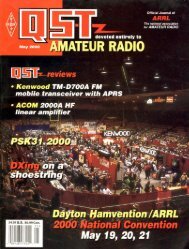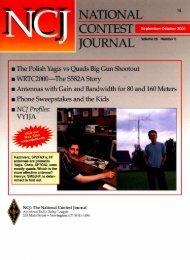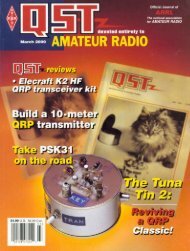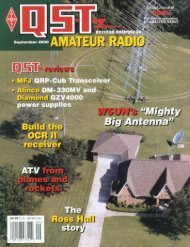You also want an ePaper? Increase the reach of your titles
YUMPU automatically turns print PDFs into web optimized ePapers that Google loves.
(in the clear) are quite usable. A quiet<br />
location is always an asset.<br />
Don’t worry about hacking up your SSB<br />
rig—no mods are needed. Keying is<br />
accomplished via audio tones (similar to<br />
most digital modes), and standard SSB<br />
filters work fine up to about 10,000 LPM<br />
(<strong>2000</strong> WPM). The emission designator—<br />
J2A—produces keying that is indistinguishable<br />
from keying the main carrier.<br />
It’s the same method used by many rigs to<br />
produce CW. 13<br />
Using standard SSB filters, the bandwidth<br />
of an HSCW signal is about the same as that<br />
of a voice transmission. For more technical<br />
information, see the numerous papers on the<br />
HSCW Web sites and the resources listed in<br />
the article by Jim McMasters, KD5BUR<br />
(now KM5PO). 14<br />
HSCW MS operation is decidedly<br />
different from conventional CW or SSB<br />
meteor-scatter operation. Both require<br />
overdense bursts or good (strong and long)<br />
underdense pings to complete a contact.<br />
SSB and slow CW operators hope for<br />
specular reflections from heavily ionized<br />
trails instead of “the abominable ping,” as<br />
one writer put it. Unfortunately, overdense<br />
bursts are usually observed only during<br />
major meteor showers.<br />
HSCW relies on the numerous subsecond<br />
bursts and the weak pings scattered<br />
from underdense particle trains. Pings of this<br />
type are often produced by the “sporadic”<br />
particles that constantly bombard the earth.<br />
Most of the debris that the earth “sweeps”<br />
into as it orbits the sun are not fragments<br />
from the asteroid belt but are particles from<br />
the dust trails left by ancient comets. The<br />
particles are widely distributed and no<br />
longer dense enough to produce recognizable<br />
showers. Their number may vary<br />
significantly from day to day—and even<br />
minute to minute. Most of these particles are<br />
no larger than grains of sand or specks of<br />
dust, but because of their extreme speed, the<br />
ionization they produce as they burn in the<br />
atmosphere is often enough to scatter or even<br />
refract radio waves. 15<br />
The duration of these pings is usually<br />
very short, but the number of tiny pings<br />
available on many mornings may surprise<br />
you. It’s been estimated that if you have a<br />
5% chance of completing a contact on SSB,<br />
your odds improve to 95% on HSCW. Of<br />
the approximately 215 completed HSCW<br />
contacts between W8WN and KO0U/K0XP,<br />
no more than 10 contacts could have been<br />
accomplished on SSB. Nearly all of those<br />
would have taken place during showers,<br />
when SSB MS comes into its own.<br />
Meteor scatter (using any mode) is<br />
difficult at distances of less than 500 miles<br />
(800 km) or greater than 1400 miles<br />
(2250 km) because of the height of the<br />
meteor trails, antenna characteristics, the<br />
30 <strong>November</strong> <strong>2000</strong><br />
An 11-element Yagi on telescoping paint<br />
pole for portable operation at our son<br />
Steve’s home near Clio, Michigan.<br />
The “basement-portable” operating<br />
position at Clio, Michigan. The hardware<br />
includes an IC-706 MKII transceiver, 150-W<br />
amp, MFJ switching power supply, Bird<br />
wattmeter, GW2K laptop computer running<br />
WinMSDSP, audio filter and coffee cup!<br />
Notice the very fancy recycled cardboard<br />
box operating table they gave me!<br />
WinMSDSP. Here we have the main MSDSP<br />
screen, and the flutter-type QSB on an<br />
overdense burst (burst length, 8.9 sec).<br />
scattering mechanism, etc. 16 For close-in<br />
communication, back- or side-scatter<br />
techniques (or antennas that can be aimed in<br />
elevation and azimuth) are usually needed.<br />
At distances beyond 1400 miles, a good<br />
location and plenty of power are necessary.<br />
Although difficult, unusually long and short<br />
QSO paths are possible during showers.<br />
Because HSCW relies entirely on signals<br />
scattered from underdense meteor trains, the<br />
typical sporadic ping will be weak and very<br />
short. So, when it comes to output power—<br />
the more the merrier. Does this mean that a<br />
150-W station can’t take advantage of<br />
sporadic underdense pings To see what<br />
could be done, I talked my daughter,<br />
WD8KVD, into letting me operate portable<br />
from her home near Duluth, Minnesota,<br />
when I visited in July of 1999.<br />
My IC-706 transceiver drove a 150-W<br />
amplifier and an 11-element Yagi that was<br />
mounted on a telescoping paint pole about<br />
20 feet (6 meters) above the ground. The<br />
location was merely fair for VHF. I used an<br />
old laptop computer to run the Windows or<br />
DOS version of MSDSP. 17 Compared with<br />
the kilowatt and the large array at home in<br />
Kentucky, contacts were more difficult, of<br />
course, but a number of ops were able to<br />
add a new grid to their logs.<br />
An indoor portable operation was<br />
repeated at Christmas 1999 from my son’s<br />
home near Clio, Michigan (EN83). Using<br />
the same equipment but with very flat<br />
terrain, contacts between 500 and 1000<br />
miles were easily made. (Details and photos<br />
from both operations are available on the<br />
W8WN Web site. 18 )<br />
Since then, K9KNW/MM has completed<br />
a number HSCW contacts from his boat,<br />
running either a halo or a small beam.<br />
During May of <strong>2000</strong>, K9KNW completed<br />
28 HSCW contacts while sailing in seven<br />
water grids (EL93, FL03, 13, 14, 15, 23 and<br />
24). His 12-element Yagi was only about<br />
three meters above the water, limiting his<br />
maximum QSO distance to about 1250<br />
miles (<strong>2000</strong> km). Stations less than 1100<br />
miles (1775 km) distant found the contacts<br />
to be quite easy, usually taking less than<br />
20 minutes. Those at greater distances were<br />
more difficult. Joe has plans for more trips,<br />
including a possible grid-hopping trip with<br />
much more time devoted to Amateur Radio.<br />
How Fast is Fast<br />
Obviously, higher-speed transmissions<br />
can pack more information into each ping.<br />
MS speeds were originally 25-35 WPM<br />
(still the standard for slow CW operation).<br />
Several pioneer operators could operate at<br />
50 WPM, copying in their heads. When the<br />
Europeans developed HSCW, routine<br />
speeds increased to <strong>2000</strong> LPM (400 WPM)<br />
or more. The current version of WinMSDSP<br />
is capable of speeds up to 20,000 LPM<br />
(4000 WPM). But are these extreme speeds<br />
practicable And what is the maximum<br />
usable speed<br />
Although contacts have been made at<br />
higher speeds, the practical MS speed limit<br />
is about 12,000 LPM (2400 WPM) (using<br />
unmodified SSB transceivers with standard<br />
SSB filters and audio tone keying). At higher<br />
speeds, the signal-to-noise ratio degrades and<br />
the keying begins to sound “soft” and<br />
indistinct. Remember that, using a <strong>2000</strong>-Hz<br />
injection tone and receiving with a 1500-Hz<br />
tone, a single dit may not even occupy a full<br />
audio cycle! By using wider filters and<br />
higher tone frequencies, faster data rates may<br />
be possible, but none of the MSDSP test

















